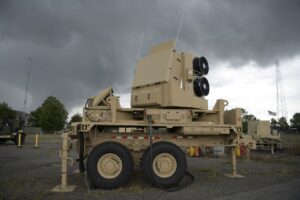Lockheed Martin [LMT] officially delivered the first five Sentinel A4 radars to the Army in late May, the company said this week, with the new systems now set to undergo operational testing.
The first batch of Sentinel A4 radars, which will replace the Sentinel A3 built by
Thales and Raytheon Technologies [RTX], will be followed by delivery of a second group of five radars to begin next March.

“Our team understands the criticality of this technology and the need to get it fielded,” Mark Mekker, Lockheed Martin’s director for Army radars, said in a statement. “Our soldiers are in unpredictable environments, and the Sentinel A4 will provide improved eyes on the field to keep them safe.”
Lockheed Martin was awarded the potential $281 million low-rate initial production contract for Sentinel A4 in September 2019 that includes options for delivery of up to 18 of the new version of the AN/MPQ-64 Sentinel radars (Defense Daily, Sept. 25 2019).
Last October, Lockheed Martin said the Army had awarded the company an accelerated contract to begin production on five additional Sentinel A4 radars, speeding up the program’s overall timeline (Defense Daily, Oct. 13 2021).
“Last year, because of the progress we were making on the program, the Army felt comfortable enough with the program to order five additional systems early. These are going to be what are called user evaluation systems,” Mekker told reporters during an April media visit at the company’s manufacturing facility in Syracuse, New York, where it’s building the radars.
Mekker said at the time that the testing with the first group of five Sentinel A4 radars is expected to last from eight to 12 months (Defense Daily, April 26).
More specifically, Lockheed Martin said the first batch of radars now with the Army will go through mobility, environmental, radar performance and logistics testing.
The upgraded version of the Sentinel radar, which provides air surveillance and fire control data, transitions the system to Active Electronically Scanned Array technology and is designed to identify and track multiple threats simultaneously, including cruise missiles, unmanned aerial systems, rotary wing and fixed wing aircraft, and rocket, artillery, and mortar threats.